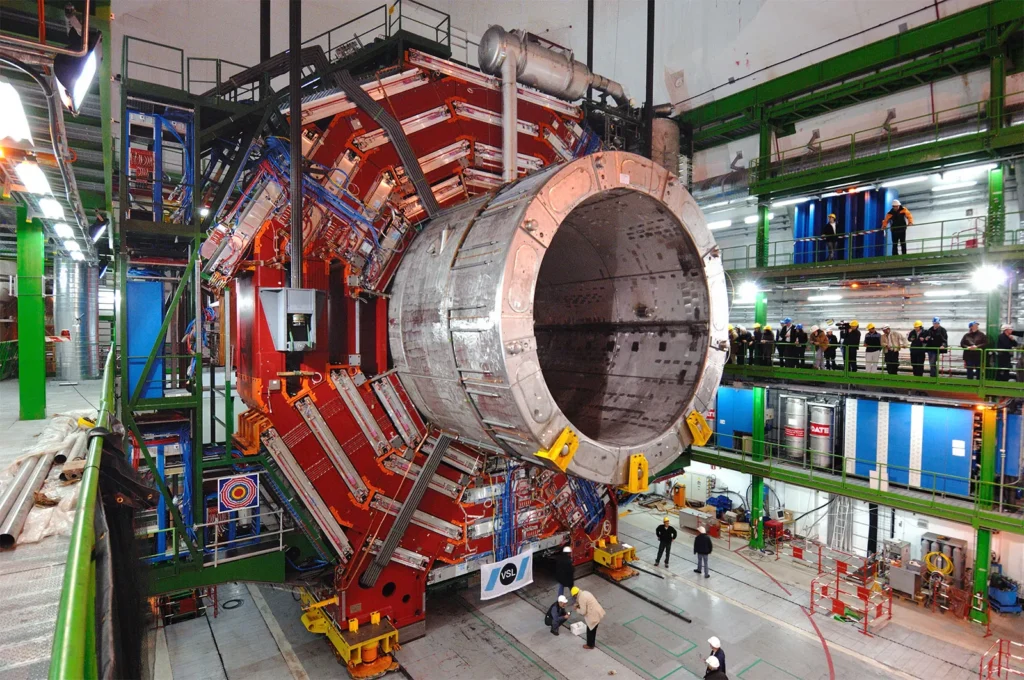You may have seen sensational headlines: “CERN finds fourth dimension!” or “Ghost structure discovered inside accelerator”. That’s not quite right — CERN hasn’t cracked open a new spatial dimension. What’s really going on is more subtle, more mathematical, and still pretty fascinating. In 2024, particle accelerator physicists reported evidence for a resonant “ghost” structure inside the SPS, which can deviate and degrade beams. This isn’t a literal fourth spatial dimension, but a 4D mathematical framework needed to characterize a time-evolving 3D resonance in phase space. In short: no portals, no fantasy dimensions — but yes, real physics work that matters for how accelerators perform.
Let’s walk through what the “ghost” is, why people are waving their arms about 4D, and what it really means for CERN and beam physics.
What Was Observed: The “Ghost” Resonance in the SPS

In 2024, researchers at CERN and collaborators reported that in the Super Proton Synchrotron (SPS) they had detected a subtle resonant structure which can nudge particles off their expected paths, causing beam degradation.
They refer to this as a “ghost” because it’s invisible in a direct sense — you don’t see a physical thing floating in the tunnel. Instead, through careful measurements of particle trajectories and beam positions, they inferred a resonant influence, a coupling in phase space, that alters how particles move.
Because this structure shifts and evolves over time, they found that describing it requires adding time (or equivalently some parameterization) to the spatial model. That is part of why they call it “4D” in a mathematical sense.
So, the “ghost” is really a resonance in the coupled dynamics of the beam, not a tangible shape drifting through the vacuum tube.
Why “4D” and Not Just 3D? The Role of Time and Phase Space
One might ask: if the resonance is a 3D shape (or region) in the accelerator, why do physicists insist on calling it 4D? The key is that the shape is not static — it evolves, and to parameterize its evolution, time (or effectively a fourth coordinate) must be included.
In accelerator physics, particle motions are often tracked in phase space, which includes coordinates such as position and momentum (or angles), not just spatial location. To fully capture how a resonance structure changes, one needs extra dimensions in that parameter space.
In this SPS case, the “ghost” resonance couples horizontal and vertical motion and evolves over time, so describing it demands a mathematical description in four degrees of freedom.
Thus, calling it “4D” is shorthand for “a resonance requiring four variables (or degrees of freedom) to map” — not for “a new, physical fourth dimension of space.”
How the Ghost Diverts and Degrades Beams
Why should we care about this ghost? Because in a high-precision accelerator, the slightest resonance can steal particles from your beam, degrade beam quality, or create instabilities. In the SPS, particles are meant to follow a controlled orbit, but if resonant lines are present, some particles get nudged away from their ideal path.
Over many laps around the ring, these deviations accumulate, leading to beam loss or “halo” particles that stray far from the intended core. That degrades the beam’s brightness and can impede experiments downstream.
By mapping the ghost resonance’s geometry and how it evolves, physicists hope to anticipate where particles are likely to fall off, and mitigate or dampen the effect. In practice, that could mean tuning magnet strengths, re‐optimizing lattice parameters, or introducing active correction schemes.
Thus, what seems abstract (a “ghost in 4D”) becomes quite concrete in beam optimization efforts.
Why It’s Not a Discovery of a Physical Fourth Spatial Dimension

Let’s be clear: there is no claim by physicists that CERN has discovered a new spatial dimension (a direction orthogonal to x, y, z). The “4D” in this context is mathematical, not physical.The resonance lives in phase space (which mixes coordinates and momenta), not in our everyday three-dimensional space. The extra “dimension” emerges when you need additional degrees of freedom (e.g. coupling, timing) to fully describe the system.
In other words: the ghost is not a portal, a wormhole, or a hidden corridor to another universe. It’s a resonance pattern in a complex accelerator system, describable in four variables.
Still, since people often conflate “4D” with “mystical extra dimension,” it’s worth stressing the difference. The work doesn’t immediately speak to beyond-standard models or spacetime extensions — although the techniques and insights might one day bear relevance in more speculative physics.
What This Means Going Forward: Mitigation, New Designs, and Theoretical Bridges
The immediate payoff is practical. By understanding the ghost resonance better, accelerator physicists can:
- Design more stable magnets and lattice configurations that avoid strong resonant couplings.
- Insert corrective elements or feedback schemes that dampen the ghost’s influence.
- Improve beam lifetime and brightness, especially important as beams push ever higher in energy and precision.
In addition, the mathematical and computational techniques developed to model this structure could feed into more ambitious theoretical work. For instance, the notion of evolving “ghosts” in high dimensional phase space has analogies in dynamical systems theory, nonlinear mechanics, and even some speculative extra-dimension models.
So, while the work does not confirm extra spatial dimensions, it may sharpen the tools and language that theorists use when wrestling with more exotic models.
Conclusion: A Haunting, Not a Revelation — But Worth Watching
So, to sum up: No, CERN did not discover a literal fourth spatial dimension in 2024. What they did was detect a resonant “ghost” in the SPS — a dynamically evolving 3D structure in phase space, which becomes more intelligible when you treat it as “4D” (i.e. including time or extra variables).
This ghost matters because it affects particle trajectories, causing beam degradation over many cycles. By modeling it, physicists hope to tame it, leading to cleaner, more reliable beams.
It’s a fascinating development — less science fiction than real-world physics, but full of nuance, challenge, and potential. If popular headlines overshoot by promising “fourth dimensions found,” the real story is still compelling: a hidden influence inside CERN’s accelerator machinery that is only now coming into focus through measurement, theory, and simulation.



